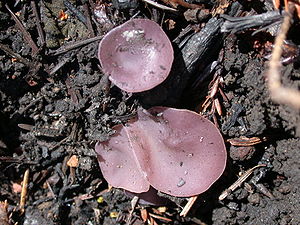Becherling relatives
| Becherling relatives | ||||||||||||
|---|---|---|---|---|---|---|---|---|---|---|---|---|

Violet Becherling ( Peziza violacea ) |
||||||||||||
| Systematics | ||||||||||||
|
||||||||||||
| Scientific name | ||||||||||||
| Pezizaceae | ||||||||||||
| Dumort. |
The muglings relatives (Pezizaceae) form a family in the order of the muglings-like (Pezizales) within the department of the hose mushrooms . They contain 25 genera with around 200 species.
features
Macroscopic features
The cup relatives usually have fleshy, soft, brittle, cup-shaped fruit bodies (Ascomata), which can vary between a few millimeters and 10 cm in diameter. However, there are also many truffle-like hypogean , i.e. subterranean species among them. Of the 25 genera described, 13 are exclusively hypogean, even in the largest genus Peziza there are several species with truffle-like fruiting bodies.
Microscopic features
The Becherling relatives are characterized by their amyloid asci , ie they turn blue with iodine, a feature that they only have in common with their sister family Ascobolaceae within the Pezizales . The genus Marcelleina with inamyloid asci is an exception . The operculate ascus is a characteristic of all Pezizales. The ascospores are mononuclear, usually thin-walled, spherical, elliptical or spindle-shaped, hyaline to pale brownish, smooth or fine black. The excipulum consists at least partially of iso diametral cells.
Ecology and diffusion
Little is known about the diet of the cup relatives, many species are considered saprotrophic , but a great many mycorrhizal fungi have also been described. Ecologically, they cover a very broad spectrum of ecological niches and colonize all possible types of soil, dung, wood and fire places. It reaches its greatest diversity in the temperate climatic zone and arctic-alpine areas. However, some species that are restricted to the tropics are also known.
Systematics
The Pezizaceae are a monophyletic family that, with the Ascobolaceae as sister family, form one of three lines within the Pezizales. The Ascobolaceae cannot be clearly separated morphologically, as characteristics are often found in both families. All representatives of the Ascobolaceae have a diffuse amyloid ascus, but some representatives of the cup-like ascus also have this type of ascus. The ascus lid is different in both families. While the family is clearly monophyletic, the opposite has been demonstrated for the Peziza genus, which is by far the largest with 84 species . Molecular phylogenetic studies of the Pezizaceae identified 14 lines within the family, with species of Peziza appearing in eight of these lines. A division into several categories has not yet been completed. The earlier family Terfeziaceae with the hypogean genera Terfezia and Tirmania are phylogenetically unique within the Pezizaceae and are therefore only a synonym .
Genera
- Amylascus
- Boudiera
- Cazia
- Eremiomyces
- Hapsidomyces
- Hydnobolites
- Hydnotryopsis
- Iodophanus
- Iodowynnea
- Kalaharituber
- Lepidotia
- Rundsporbecherlinge ( Marcelleina )
- Mattiroliomyces
- Mycoclelandia
- Thick Cups ( Pachyella )
- Crater truffles ( Pachyphloeus )
-
Real muglings ( Peziza )
- Overlooked Becherling ( Peziza praetervisa )
- Spread out mugling ( Peziza repanda )
- Blistered cup ( Peziza vesiculosa )
- Charcoal cuplings ( Plicaria )
- Rhodopeziza
- Truffle Cups ( Ruhlandiella )
- Crown cups ( Sarcosphaera )
- Scabropezia
- Fold balls ( Sphaerozone )
- Desert truffles ( Terfezia )
- Amyloid Truffles ( Tirmania )
literature
- Donald Karen Hansen, H. Pfister: Systematics of the Pezizomycetes - the operculate discomycetes. In: Mycologia . tape 98 , no. 6 , 2006, p. 1029-1040 , doi : 10.3852 / mycologia.98.6.1029 ( mycologia.org [PDF; 990 kB ]).
Individual evidence
- ^ OE Eriksson: Outline of Ascomycota . In: Myconet . tape 12 , 2006, ISSN 1403-1418 , pp. 1-82 .
- ^ Paul M. Kirk, Paul F. Cannon, David W. Minter, JA Stalpers: Dictionary of the Fungi . 10th ed. CABI Europe, Wallingford, Oxfordshire (UK) 2008, ISBN 978-0-85199-826-8 (784 pages).
- ^ A b Karen Hansen, Thomas Læssøe, Donald H. Pfister: Phylogenetics of the Pezizaceae, with an emphasis on Peziza . In: Mycologia . tape 93 , no. 5 , 2001, p. 958-990 ( harvard.edu [PDF; 2.9 MB ]).
- ↑ JW Kimbrough: Septal infrastructure and ascomycete systematics . Ascomycete systematics: problems and perspectives in the nineties. Ed .: DL Hawskworth. Plenum Press, New York (USA) 1994, pp. 127-141 .
- ^ JE Norman, KN Egger: Molecular phylogenetic analysis of Peziza and related genera . In: Mycologia . tape 91 , 1999, p. 820-829 .
- ↑ Karen Hansen, KF LoBuglio, Donald H. Pfister: Evolutionary relationships of the cup-fungus genus Peziza and Pezizaceae inferred from multiple nuclear genes: PRB2, b-tubulin, and LSU rDNA . In: Molecular Phylogenetics and Evolution . tape 36 , no. 1 , 2005, p. 1-23 .
- ↑ Karen Hansen, JM Trappe: Terfeziaceae E. Fisch. Notes on ascomycete systematics. Nos 3303-3579. In: OE Eriksson, Hans-Otto Baral, RS Currah, Karen Hansen, CP Kurtzman, G. Rambold, Thomas Læssøe (eds.): Myconet . tape 8 , 2002, ISSN 1403-1418 , pp. 1-54 .